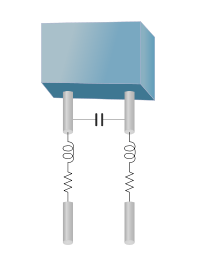Parasitic element (electrical networks)

In electrical networks, a parasitic element is a circuit element (resistance, inductance or capacitance) that is possessed by an electrical component but which it is not desirable for it to have for its intended purpose. For instance, a resistor is designed to possess resistance, but will also possess unwanted parasitic capacitance.
Parasitic elements are unavoidable. All conductors possess resistance and inductance and the principles of duality ensure that where there is inductance, there will also be capacitance. Component designers will strive to minimise parasitic elements but are unable to completely eliminate them.
The most commonly seen manifestations of parasitic elements in components are in the parasitic inductance and resistance of the component leads and the parasitic capacitance of the component packaging. For wound components such as inductors and transformers, there is additionally the important parasitic effect of capacitance that exists between the individual turns of the windings. This winding parasitic capacitance will cause the inductor to act as a resonant circuit at some frequency, at which point (and all frequencies above) the component is useless as an inductor.
Parasitic elements are often modelled as lumped components in equivalent circuits but this is not always adequate. For instance, the inter-winding capacitance mentioned above is really a distributed element along the whole length of the winding and not a capacitor in one particular place. Designers sometimes take advantage of parasitic effects to achieve a function in a component, see for instance helical resonator.
Non-linear parasitic elements can also arise. The term is commonly used to describe parasitic structures formed on an integrated circuit whereby an unwanted semiconductor device is formed from p-n junctions which belong to two or more intended devices or functions.
References
- John L. Semmlow, Circuits, signals, and systems for bioengineers, pp. 134–135, Academic Press, 2005 ISBN 0-12-088493-3.
- Steven H. Voldman, ESD: Failure Mechanisms and Models, pp. 13–14, John Wiley and Sons, 2009 ISBN 0-470-51137-0.